Postwar Suburbs 1945-1965
Quote
Eighty percent of everything ever built in America has been built in the last fifty years, and most of it is depressing, brutal, ugly, unhealthy, and spiritually degrading - the jive-plastic commuter tract home wastelands, the Potemkin village shopping plazas with their vast parking lagoons, the Lego-block hotel complexes, the ‘gourmet mansardic’ junk-food joints, the Orwellian office ‘parks’ featuring buildings sheathed in the same reflective glass as the sunglasses worn by chain-gang guards, the particle-board garden apartments rising up in every meadow and cornfield, the freeway loops around every big and little city with their clusters of discount merchandise marts, the whole destructive, wasteful, toxic, agoraphobia-inducing spectacle that politicians proudly call ‘growth.’
James Howard Kuntsler, The Geography of Nowhere: The Rise and Decline of America’s Man-Made Landscape
Resources
An interesting way to start your research is to delve into the attitude of the people of the time. To this end, we have linked to some videos and pamphlets that represent the feelings of the postwar public. These resources give a feel for the consumerism and optimism that characterized a time in American history where everything seemed possible. Enjoy these resources and gain a deeper understanding of the the mid-twentieth century.
Little Boxes
Little boxes on the hillside,
Little boxes made of ticky-tacky,
Little boxes on the hillside,
Little boxes all the same.
There's a green one and a pink one
And a blue one and a yellow one
And they're all made out of ticky tacky
And they all look just the same
And the people in the houses
All went to the university,
Where they were put in boxes,
And they came out all the same
And there's doctors and lawyers
And business executives,
And they're all made out of ticky tacky
And they all look just the same.
And they all play on the golf course,
And drink their martinis dry,
And they all have pretty children,
And the children go to school.
And the children go to summer camp
And then to the university,
And they are put in boxes
And they all come out the same.
And the boys go into business,
And marry and raise a family,
In boxes made of ticky tacky,
And they all look just the same.
There's a green one and a pink one
And a blue one and a yellow one
And they're all made out of ticky tacky
And they all look just the same.
From the song, Little Boxes. Words and music by Malvina Reynolds. Copyright 1962 Schroder Music Co. (ASCAP). Renewed 1990. Used by permission. All rights reserved. Malvina's daughter, Nancy Schimmel, is writing a biography of her mother and is blogging about the process.
Films
These films and others are available from the online Prelinger collection at the Internet Archive.
All the Way Home
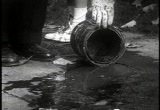 All the Way Home portrays how a neighborhood acts when the seller of a house opts to sell to an African American family. Produced by Dynamic Films, Inc. in 1957, it showcases the issues of racial and housing discrimination.
All the Way Home portrays how a neighborhood acts when the seller of a house opts to sell to an African American family. Produced by Dynamic Films, Inc. in 1957, it showcases the issues of racial and housing discrimination.
Links:
Crisis in Levittown
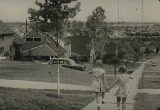 Crisis in Levittown was produced by Dynamic Films in 1957. This powerful landmark documentary showcases the racism the African American Myers family were subjected to when they moved into the all-white Levittown in Pennsylvania.
Crisis in Levittown was produced by Dynamic Films in 1957. This powerful landmark documentary showcases the racism the African American Myers family were subjected to when they moved into the all-white Levittown in Pennsylvania.
Links:
In the Suburbs
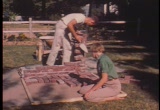 In the Suburbs was produced by On Film, Inc. and sponsored by Redbook Magazine. This 1957 film portrays American suburban culture from the viewpoint of burgeoning families and showcases the ever growing consumption of appliances, accessories, and packaged components.
In the Suburbs was produced by On Film, Inc. and sponsored by Redbook Magazine. This 1957 film portrays American suburban culture from the viewpoint of burgeoning families and showcases the ever growing consumption of appliances, accessories, and packaged components.
Links:
Give Yourself the Green Light
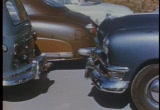
Give Yourself the Green Light was sponsored by the General Motors Corporation, Department of Public Relations. This 1954 film advocates for better roads and highways.
Links:
The Quiet Revolution
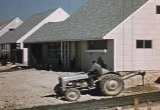 The Quiet Revolution was produced and sponsored by the Ford Motor Company, Tractor and Implement Division. This 1956 film showcases Ford's construction equipment and gives us a window into how housing developments, such as Levittown, Pennsylvania, were built.
The Quiet Revolution was produced and sponsored by the Ford Motor Company, Tractor and Implement Division. This 1956 film showcases Ford's construction equipment and gives us a window into how housing developments, such as Levittown, Pennsylvania, were built.
Links:
G.I. Roundtable Pamphlets
Shall I Build A House After the War?
By Anthony Netboy, Editorial Staff, Department of Agriculture (the G.I. Roundtable Series of the American Historical Association)
What Will Your Town Be Like?
By Millard C. Faught, Committee for Economic Development (the G.I. Roundtable Series of the American Historical Association)
What is the Future of Television?
By Robert Farr, Staff Writer, Science Service (Institute for the Popularization of Science) (the G.I. Rountable Series of the American Historical Association)
For background information, analysis and additional pamphlet topics, please go to "Constructing a Postwar World," The G.I. Roundtable Series in Context, the Web archive that contains the online publication of these G.I. pamphlet series of the American Historical Association (AHA). Per Robert B. Townsend, AHA Assistant Director for Research and Publications, who analyzed the documents, "the accent in the pamphlets is on what the postwar world would look like, and reassuring servicemen that they would have a place in postwar America. The AHA tailored its pamphlets to paint an idealized image of a postwar world that was essentially free of minorities, where women happily moved out of the factories and back into the kitchen, and where America would largely dominate the world stage."